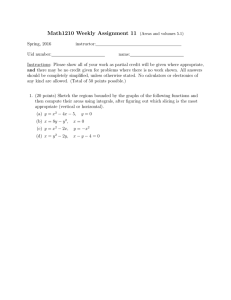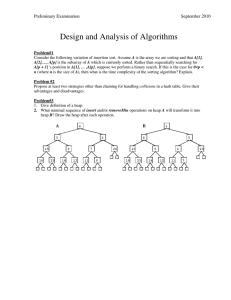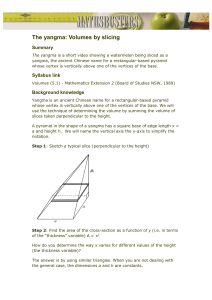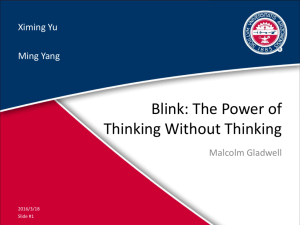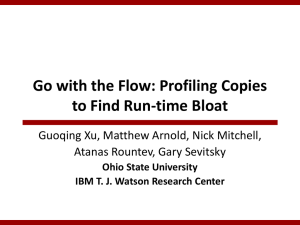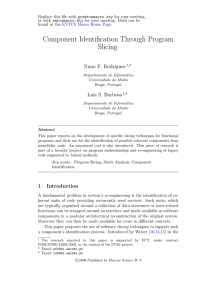Finding Low-Utility Data Structures Guoqing Xu , Nick Mitchell , Matthew Arnold
advertisement
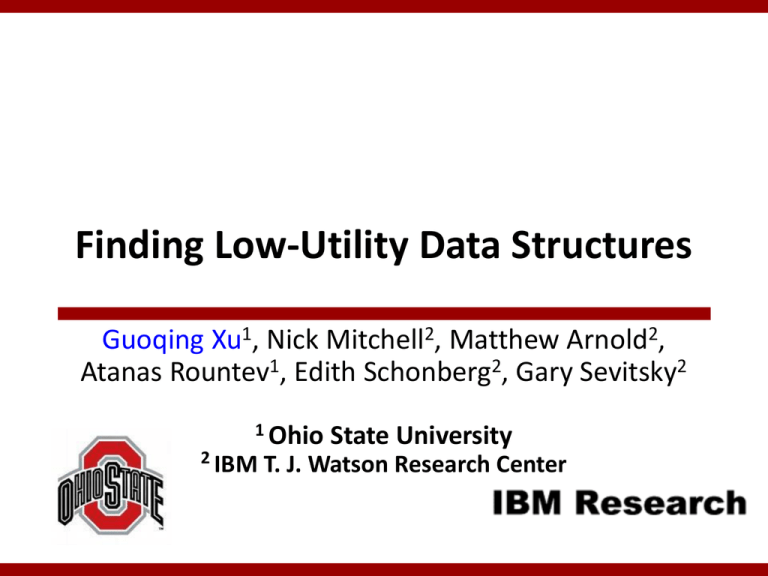
Finding Low-Utility Data Structures
Guoqing Xu1, Nick Mitchell2, Matthew Arnold2,
Atanas Rountev1, Edith Schonberg2, Gary Sevitsky2
1 Ohio
2 IBM
State University
T. J. Watson Research Center
The State-of-the-Art
Bloat can manifest itself through many symptoms
temporary objects [Dufour FSE’08, Shankar OOPSLA’08]
excessive data copies [Xu PLDI’09]
highly-stale objects [Bond ASPLOS’06, Novak PLDI’09]
problematic container behaviors [Xu ICSE’08, Shaham PLDI’09,
Xu PLDI’10]
…
Is there a common way to characterize bloat?
At the heart of all inefficiencies lie computations, with
great expense, produce data values that have little impact
on the forward progress
2
What’s Common About Bloat
boolean isResourceDir(IResource s){
List dirs = computeAllDirs();
Blame the List object !!
return dirs.contains(s);
}
List computeAllDirs(){
//find and return all directories under the working dir
}
--- from eclipse
3
Cost And Benefit
• Absolute cost of a value: total number of
instructions executed to produce it
– a = b or a = b + c, each has unit cost
• Benefit of heap value v:
v
(output) : benefit is a very large number
v
v
(not used) : benefit is 0
M
v’ : benefit is M (amount of work)
Cost Computation
Appears to a problem that can be solved by taint-like
flow tracking
b = 10;
a = b + 3;
ta = tb + 1;
c = b * 5;
tc = tb + 1;
d = a / c;
td = ta + tc + 1;
The cost of d is 4
5
Double
counted
tb = 1;
td is 5 ?
It is a backward dynamic flow problem
Requires dynamic slicing in general
Abstract Dynamic Thin Slicing
Regular
Thin slicing
slicing[Sridharan-PLDI’07]
b = …; b.m = …;
a = b.m;
• Trace required by dynamic (regular and thin) slicing
is unbounded
– The entire execution needs to be recorded
– Many more details than a client would need
• For some problems, equivalence classes exist
6
E1
a = b.m1 a = b.m3 a = b.m67 a = b.m23 a = b.m1235 …
E2
a = b.m45 a = b.m217 a = b.m29 a = b.m35 a = b.m9 …
Abstract Dynamic Thin Slicing
• Introduce analysis semantics into profiling
Static instruction domain I;
Regular dep. graph
7
Abstract dep. graph
Natural numbers domain N
Bounded abstract domain D
Node: I X N
Node: I X D
Abstraction function
finstr(j) : N
D
1, 3, 67, 23, 1235
fa = b.m (j)
45, 217, 29, 35, 9
fa = b.m (j)
E1
E2
Bounded
slicing
Cost Computation
Absolute cost
Abstract cost
…
…
b=e/f 34
c=h/g2135
a = b + c 20
#nodes
b=e/f E102
c=h/g E47
a = b + c E0
Σ(n.size)
• Absolute cost is expensive to compute
• It does not make sense to help problem diagnosis
8
Cost Computation As Abstract Slicing
• D = the set of calling contexts
– Object-sensitivity is used [Milanova-TOSEM’05]
– Each element is a chain of receiver object alloc sites
• Further reduce D to a finite bounded domain Dcost
– A set {0, …, s – 1} with fixed size s
• finstr(j) is a three-step function
– Details can be found in the paper
9
Relative Abstract Cost
Cumulative
Relative
costcost
O1
…
Program input
f
…
…
h
j
…
…
g
…
…
O3
O2
– Cumulative cost measures the effort made from the
beginning of the execution to produce a value
– It is certain that the later a value is produced, the
higher cost it has
10
Relative Abstract Benefit
O1
…
Program input
f
…
…
…
g
…
O2
Relative benefit
O4
k
h
j
O3
…
l
…
O5
– Abstract benefit: the effort made to transform a value read
from a heap loc l to the value written into another heap loc l
– The more heap values are produced, the higher the benefit of l
– The more complex the transformation is, the higher the benefit
of l
11
Case Studies
•
•
•
•
•
•
•
sunflow: 9-15% running time reduction
bloat: 35% running time reduction
eclipse: 14.5% running time reduction
derby: 6% running time reduction
tomcat: 2% running time reduction
Trade: 2.5% running time reduction
Summary
– Computation of data not necessarily used
– Choices of unnecessary (expensive) operations
– Certain usage patterns for inner classes are harmful
12
Overhead
• Implemented in J9 - the IBM commercial JVM
• Space overhead
– Shadow heap: has the same size as the Java heap
– Less than 20Mb for the dependence graph
• Time overhead
– 71 slowdown: track every instruction and perform
synchronization when dependence graph is updated
• Reducing overhead
– Selective profiling
– Sampling
– Various static pre-processing techniques
13
Conclusions
• A run-time analysis that detects bloat by looking
for high-cost-low-benefit operations
– As opposed to symptoms-based bloat detection
• Achieve scalability using abstract slicing
– A general technique for a variety of backward dynamic
flow problem
• Found many optimization opportunities in large
real-world Java applications
14
Thank you
15
